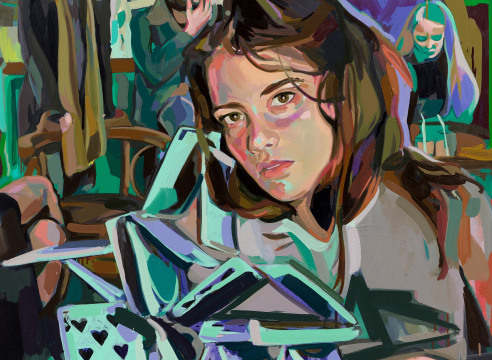
Fredericks & Freiser is pleased to announce an exhibition of new paintings by Anna Kenneally (b.1995, lives and works in London). Kenneally’s quixotic figures are sequestered at the fringes of society. Evoking a Victorian Gothic melancholy, they radiate the aesthetics of darkness as they navigate uncharted surroundings like vagrants picking over decimated landscapes. Her neo-romanticism favors subversive poses amongst erratic brushwork in order to highlight a disconnect to the natural world. Kenneally is part of a new generation of painters whose practices render passé the battle between abstraction and figuration. For these artists, there is no conflict between the two as they now exist side-by-side with knowing nonchalance; similarly, there is no clash of high and low cultural references - all sources emerge on an equal footing.
The fifteen paintings in “Colour in the Shadows” combine the unknowable reverie of Rousseau’s Primitivist compositions, the fear and chaos of global warming in post-apocalyptic science fiction novels, the emphatic colorful gestures of The Brücke artists, the dramatic sonics of Dark Wave music, and the intimate yet anxious tenor of her generation’s most inspired figuration. There are specific art historical references—from Klein to Munch—as Kenneally demonstrates painterly command of canonical forms that define the discipline: the artist’s devotion to the female form is central to her practice.
Set against disquieting vistas that sometimes appear abandoned and unhabitable, the figures are not fully defined or contained by clean linearity and instead rely on patches of color to give form to their bodies. Dramatic shifts in light sources illuminate some details while casting others further into mystery. Kenneally’s gothic portrayals of unruly forms in decimated landscapes come alive through brushwork that captures heat, energy, and heightened moments of contact. Hyper-painterly and bursting with color, they ultimately consider humans’ warped relationship with nature and their uneasy alliance with each other.